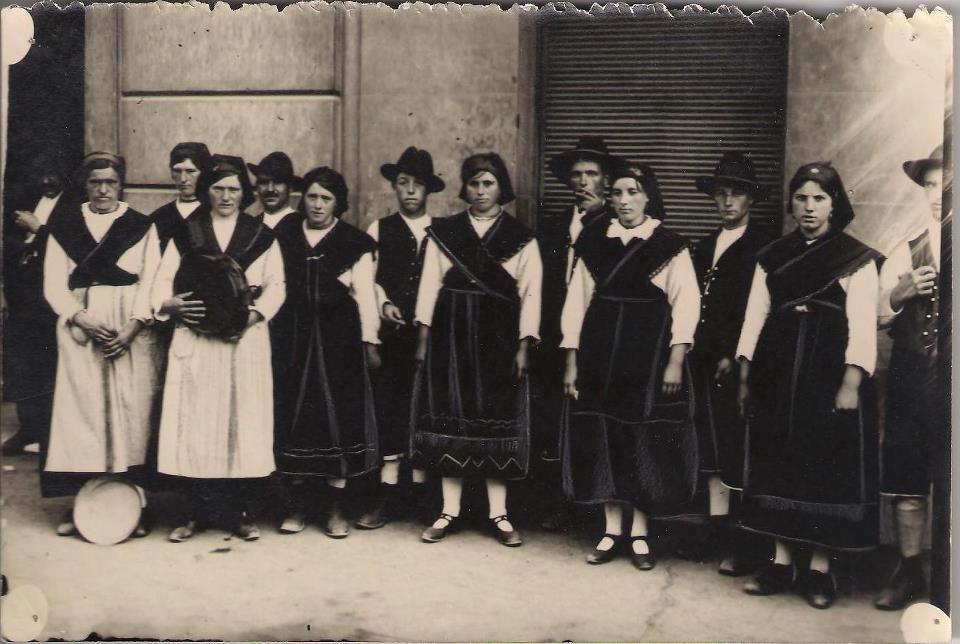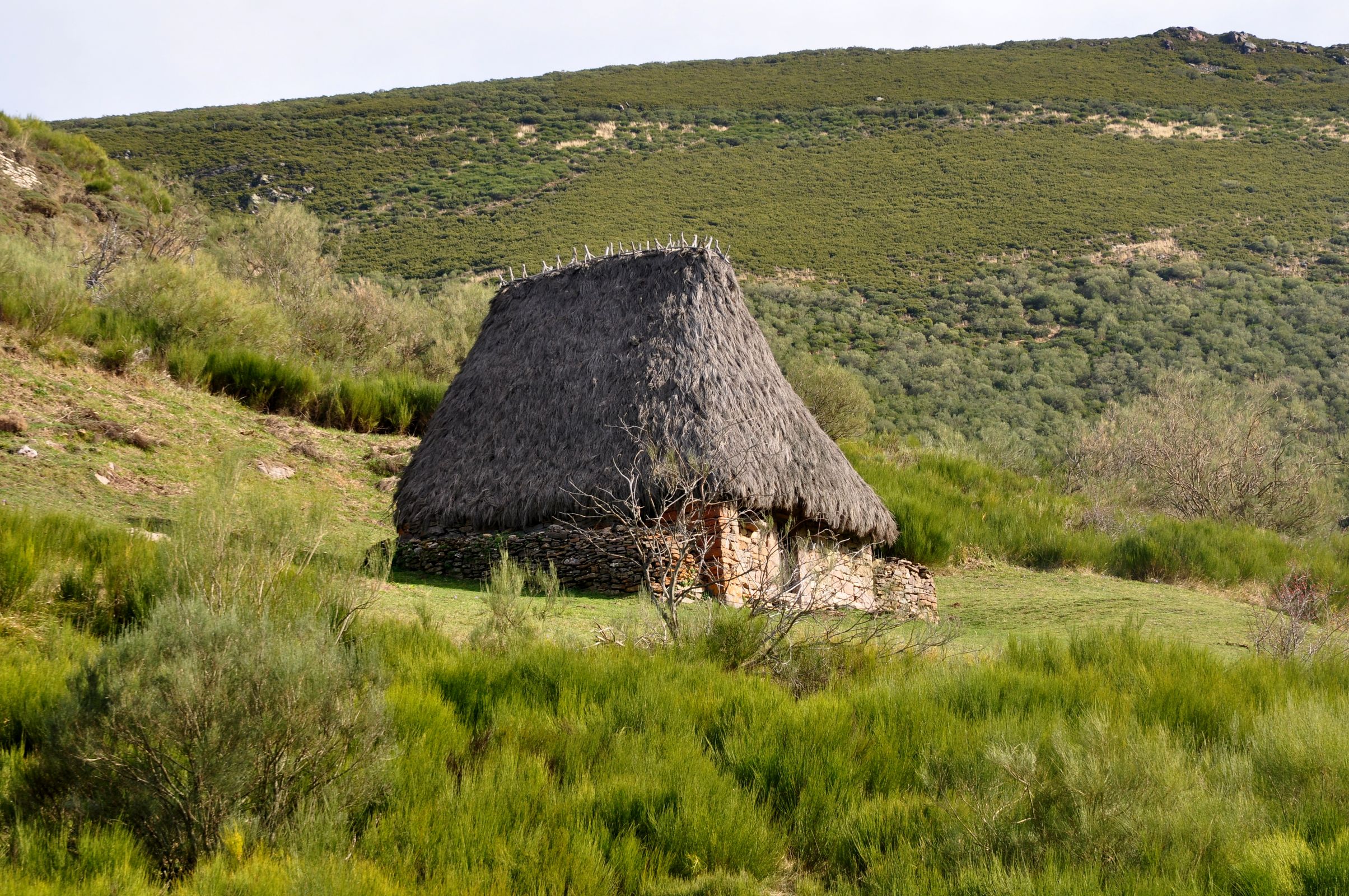|
Vaqueiros De Alzada
The Vaqueiros de Alzada ( Asturian: Vaqueiros d'Alzada, "nomadic cowherds" in Asturian language, from their word for cow, cognate of Spanish ) are a northern Spanish nomadic people in the mountains of Asturias and León, who traditionally practice transhumance, i.e. moving seasonally with cattle. Vaqueiros have a culture separate from their non-Vaqueiro Asturian and Leonese neighbors and can often be distinguished by their last names, many of which are unique to Vaqueiros including Alonso, Ardura, Arnaldo, Berdasco, Boto, Calzón, Feito, Gancedo, Gayo, Lorences, Parrondo, Redruello, Riesgo, Sirgo, and Verdasco among others. Distribution The ancestral territory of the Vaqueiros is in western Asturias and northwestern León. The traditional communities, or brañas, of the Vaqueiros can be found in the Asturian municipalities of Belmonte de Miranda, Cangas del Narcea, Cudillero, Gijón, Gozón, Llanera, Navia, Oviedo, Pravia, Las Regueras, Salas, Siero, Somiedo, Tev ... [...More Info...] [...Related Items...] OR: [Wikipedia] [Google] [Baidu] |
Spain
Spain, or the Kingdom of Spain, is a country in Southern Europe, Southern and Western Europe with territories in North Africa. Featuring the Punta de Tarifa, southernmost point of continental Europe, it is the largest country in Southern Europe and the fourth-most populous European Union member state. Spanning across the majority of the Iberian Peninsula, its territory also includes the Canary Islands, in the Eastern Atlantic Ocean, the Balearic Islands, in the Western Mediterranean Sea, and the Autonomous communities of Spain#Autonomous cities, autonomous cities of Ceuta and Melilla, in mainland Africa. Peninsular Spain is bordered to the north by France, Andorra, and the Bay of Biscay; to the east and south by the Mediterranean Sea and Gibraltar; and to the west by Portugal and the Atlantic Ocean. Spain's capital and List of largest cities in Spain, largest city is Madrid, and other major List of metropolitan areas in Spain, urban areas include Barcelona, Valencia, Seville, ... [...More Info...] [...Related Items...] OR: [Wikipedia] [Google] [Baidu] |
Asturian Language
Asturian (; )Art. 1 de lLey 1/1998, de 23 de marzo, de uso y promoción del bable/asturiano [Law 1/93, of March 23, on the Use and Promotion of the Asturian Language/nowiki>] is a West Iberian languages, West Iberian Romance languages, Romance language spoken in the Principality of Asturias, Spain. Asturian is part of a wider linguistic group, the Asturleonese languages. The number of speakers is estimated at 100,000 (native) and 450,000 (second language). The dialects of the Astur-Leonese language family are traditionally classified in three groups: Western, Central, and Eastern. For historical and demographic reasons, the Standard language, standard is based on #Dialects, Central Asturian. Asturian has a distinct grammar, dictionary, and orthography. It is regulated by the Academy of the Asturian Language. Although it is not an official language of Spain, it is protected under the Statute of Autonomy of Asturias and is an elective language in schools. For much of its history ... [...More Info...] [...Related Items...] OR: [Wikipedia] [Google] [Baidu] |
Navia, Asturias
Navia is a municipality in the Autonomous Community of the Principality of Asturias, Spain. It lies on the Cantabrian Sea, and is bordered by the municipalities of Villayón to the south, Valdés, Asturias, Valdés to the east, and Coaña to the west. It is also the name of a parish and a village in the municipality. The Navia River flows through the municipality. Parish (subnational entity), Parishes *Andés *Anleo *Navia (parish), Navia *Piñera (Navia), Piñera *Polavieja *Puerto de Vega *Villanueva (Navia), Villanueva *Villapedre References External linksWeb del Descenso de la ría del mismo nombre * Club Natación Villa de Navia  Municipalities in Asturias
Parishes in Navia, *
{{Asturias-geo-stub ...
Municipalities in Asturias
Parishes in Navia, *
{{Asturias-geo-stub ...
[...More Info...] [...Related Items...] OR: [Wikipedia] [Google] [Baidu] |
Llanera, Asturias
Llanera is a municipality in the Autonomous Community of the Principality of Asturias, Spain. It is bordered on the north by Gijón and Corvera de Asturias, on the south by Oviedo, on the east by Gijón and Siero, and on the west by Illas and Las Regueras. Its capital is located 11 km from Oviedo, 20 km from Avilés, and 22 km from Gijón. Renfe, the national railroad organization, has stations in Lugo de Llanera, Villabona y Ferroñes. The municipality has an important industrial sector. There are industrial parks at Silvota and Asipo. There is a penitentiary in Villabona. Lugo de Llanera was founded as a Roman settlement, named ''Lucus Asturum''. It is situated at the fork of the Roman roads to Astorga, Spain, Astorga and Cantabria. Parish (subnational entity), Parishes Notable people *Francisco Álvarez Martínez (1925–2022), cardinal of the Catholic Church *Santiago Cazorla References External linksFederación Asturiana de Concejos Municipalit ... [...More Info...] [...Related Items...] OR: [Wikipedia] [Google] [Baidu] |
Gozón
Gozón is a municipality in the Autonomous Community of the Principality of Asturias, Spain. Its capital is the town of Luanco (also called Lluanco). The Cantabrian Sea lies on its northern edge, and it is bordered to the south by Corvera de Asturias, to the west by Avilés, and to the east by Carreño. The municipality is a fishing port, and the location of the Cabo de Peñas (Cape of Boulders). Toponymy In decree 72/2005 of July 7, 2005, published in the ''Boletin Oficial del Principado de Asturias'' (BOPA; official bulletin of the Principality of Asturias) granted the Asturian forms of the municipal place names official status for all uses, with the exception of the capital Lluanco/Luanco, which maintains a bilingual name. Therefore, with this exception, the Asturian names are the only ones which can appear on road signs and official maps. Climate As with the rest of Asturias' populated areas, Gozón has a marine climate with a narrow average high temperature range b ... [...More Info...] [...Related Items...] OR: [Wikipedia] [Google] [Baidu] |
Gijón
Gijón () or () is a city and municipality in north-western Spain. It is the largest city and Municipalities of Spain, municipality by population in the autonomous communities of Spain, autonomous community of Asturias. It is located on the coast of the Cantabrian Sea in the Bay of Biscay, in the central-northern part of Asturias; it is approximately north-east of Oviedo, the capital of Asturias, and from Avilés. With a population of 273,744 as of 2023, Gijón is the Ranked lists of Spanish municipalities, 15th largest city in Spain. Gijón forms part of a large metropolitan area that includes twenty councils in the center of the region, structured with a dense network of roads, highways and railways and with a population of 835,053 inhabitants in 2011, making it the seventh largest in Spain. During the 20th century, Gijón developed as an industrial city in the steel and naval industries. However, due to the decline in manufacturing in these industries, in recent years Gij� ... [...More Info...] [...Related Items...] OR: [Wikipedia] [Google] [Baidu] |
Cudillero
Cudillero ( Asturian: ''Cuideiru'') is a municipality in the Principality of Asturias, Spain. Nowadays, Cudillero's main economic activities are related to tourism, but it is also known for its fishing industry. A legend says that it was founded by the Vikings. In addition to Castillian some locals still speak a dialect called Pixueto. Usually, Spanish-media considers Cudillero as one of the most beautiful villages in Spain. History Prehistory and Romanization The history of this municipality was linked to that of Pravia until the 18th century. As a result, it is challenging to find records pertaining solely to the current municipality of Cudillero, as its administrative boundaries did not gain autonomy until the 19th century. No prehistoric human remains have been discovered within the current territory of Cudillero, though such findings exist in neighboring municipalities. The first archaeological traces within Cudillero date to the Castro culture period, with two hillfort ... [...More Info...] [...Related Items...] OR: [Wikipedia] [Google] [Baidu] |
Cangas Del Narcea
Cangas del Narcea is the oldest municipality in the Principality of Asturias in Spain. It is also the largest municipality in Asturias. It is in the southwest of Asturias, on the Asturian border with León. Until 1927, Cangas del Narcea was known as Cangas de Tineo ( Asturian: Cangas de Tinéu). Cangas del Narcea is also the name of the municipality's capital, and one of the judicial districts in Asturias. Geography Parishes Cangas del Narcea is divided into 54 parishes: Protected areas Muniellos Wood, a nature reserve which lies within Cangas del Narcea and Ibias, is the core area of the Muniellos Biosphere Reserve (designated by UNESCO The United Nations Educational, Scientific and Cultural Organization (UNESCO ) is a List of specialized agencies of the United Nations, specialized agency of the United Nations (UN) with the aim of promoting world peace and International secur ... in 2000 and later extended). In 2002 a new natural park was created, the Natural Pa ... [...More Info...] [...Related Items...] OR: [Wikipedia] [Google] [Baidu] |
Belmonte De Miranda
Belmonte de Miranda ( Asturian: ''Miranda'') is a municipality in the Autonomous Community of the Principality of Asturias, Spain. It is bordered on the north by Salas, on the east by Grado, to the south by Somiedo and Teverga, and on the west by Tineo. Geography The municipality is crossed from south to north by the basin of the river Pigüeña, a trout-rich tributary of the Narcea, the river which forms the northern border with Salas, and which is usually fished for salmon. The southeast part of the municipality forms part of the Somiedo Natural Park. In it are a great variety of native forest species: oaks, chestnuts, and so forth. Here the fauna is varied and abundant, including wolves, foxes, badgers, roe deer, boars, and brown bear. Demography The inhabitants of the municipality are in 66 principal villages divided into 15 parishes, the largest of which is Belmonte, with 32.1 km2. Like many of the municipalities in the mountains of Asturias, Belmonte de Miranda ... [...More Info...] [...Related Items...] OR: [Wikipedia] [Google] [Baidu] |
Braña
A braña is a seasonal pasture in the Cantabrian Mountains of northwest Spain, particularly in Asturias, Cantabria, and northern León, Spain, León. Brañas support several types of transhumance and can be used during different periods of the year, though the word is most often associated with summer usage. Brañas are located in the mountains and hills far above towns, usually at between 700 and 1800 meters in altitude. Winter brañas are located at lower altitudes closer to towns, while summer brañas are located higher up in the mountains. Etymology The word ''braña'' most likely comes from the Latin meaning "summer" (compare Asturian language, Asturian ''branu'', "summer"). However, some authors attribute the word to Proto-Celtic *''brakna'', "wetland", which is the meaning of braña in Galician language, Galician. In the eastern Cantabrians, the term ''invernal'' is often used to refer specifically to winter pastures and in central and eastern Asturias the term ''majada ... [...More Info...] [...Related Items...] OR: [Wikipedia] [Google] [Baidu] |
Transhumance
Transhumance is a type of pastoralism or Nomad, nomadism, a seasonal movement of livestock between fixed summer and winter pastures. In montane regions (''vertical transhumance''), it implies movement between higher pastures in summer and lower valleys in winter. Herders have a permanent home, typically in valleys. Generally only the herds travel, with a certain number of people necessary to tend them, while the main population stays at the base. In contrast, movement in plains or plateaus ''(horizontal transhumance)'' is more susceptible to disruption by climatic, economic, or political change. Traditional or fixed transhumance has occurred throughout the inhabited world, particularly Europe and western Asia. It is often important to pastoralist societies, as the dairy products of transhumance flocks and herds (milk, butter, yogurt and cheese) may form much of the diet of such populations. In many languages there are words for the higher summer pastures, and frequently these ... [...More Info...] [...Related Items...] OR: [Wikipedia] [Google] [Baidu] |




